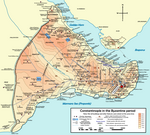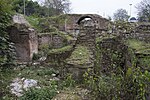Aqueduct of Valens

The Aqueduct of Valens (Turkish: Valens Su Kemeri, Ancient Greek: Ἀγωγὸς τοῦ ὕδατος, romanized: Agōgós tou hýdatos, lit. 'aqueduct') was a Roman aqueduct system built in the late 4th century AD, to supply Constantinople – the capital of the eastern Roman empire. Construction of the aqueduct began during the reign of the Roman emperor Constantius II (r. 337–361) and was completed in 373 by the emperor Valens (r. 364–378). The aqueduct remained in use for many centuries. It was extended and maintained by the Byzantines and the Ottomans. Initially, the Aqueduct of Valens carried water from springs at Danımandere and Pınarca; the channels from each spring met at Dağyenice. This 4th-century first phase of the system was 268 kilometres (167 miles) long. A second, 5th-century phase added a further 451 kilometres (280 miles) of conduits that took water from Vize, 120 kilometres (75 miles) away from Constantinople.: 13 The final and most visible aqueduct bridge in the system survives in the Fatih district of Istanbul, Turkey. Named in Turkish: Bozdoğan Kemeri, lit. 'Aqueduct of the Grey Falcon', it is an important landmark in the city, with its arches passing over Atatürk Boulevard (Atatürk Bulvarı). The Bozdoğan Kemeri spans the valley between the hills that are today occupied by the Istanbul University and the Fatih Mosque, formerly the site of the Church of the Holy Apostles. The surviving section is 921 metres long, about 50 metres less than the original length.
Excerpt from the Wikipedia article Aqueduct of Valens (License: CC BY-SA 3.0, Authors, Images).Aqueduct of Valens
İtfaiye Caddesi, Istanbul
Geographical coordinates (GPS) Address External links Nearby Places Show on map
Geographical coordinates (GPS)
| Latitude | Longitude |
|---|---|
| N 41.015944444444 ° | E 28.955555555556 ° |
Address
Bozdogan Su Kemeri
İtfaiye Caddesi
34083 Istanbul
Türkiye
Open on Google Maps









